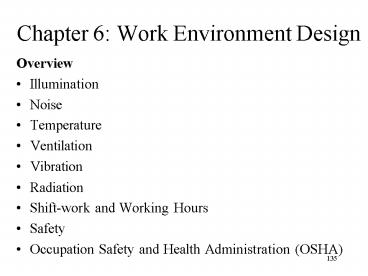Chapter 6: Work Environment Design PowerPoint PPT Presentation
1 / 23
Title: Chapter 6: Work Environment Design
1
Chapter 6 Work Environment Design
- Overview
- Illumination
- Noise
- Temperature
- Ventilation
- Vibration
- Radiation
- Shift-work and Working Hours
- Safety
- Occupation Safety and Health Administration (OSHA)
2
Illumination
- Illuminance an amount of light a
surface (intensity/d2) ? (fc foot candles d
from source to surface) - Luminance an amount of light
- illuminance reflectance
(fLfoot-lamberts) - Reflectance 0.9Ltarget/Lstandard
- Visibility the with which the human sees
something visual angle, contrast, luminance - For small targets visual angle (arc min) 3438
h/d - Contrast (Lmax Lmin)/Lmax
- Light sources efficiency (lumens/w) color
rendering - Light distribution of total light output
emitted above and below the horizontal - Glare glare happens when eyes receive the
brightness light - Color
3
(No Transcript)
4
?w -2 low -2 5
(No Transcript)
6
(No Transcript)
7
Noise
- Characteristic of noise
- Sound velocity c f? (1,100ft/sec in air)
- ? sound wave length (ft), frequency in Hz
- Sound intensity (decibel) Sound pressure
- Frequency (hertz or cycle/sec) human audible
20-20000Hz - Sound level L 20 log (Prms/Pref) (dB)
- Prms root-mean-square sound pressure
(microbars) - Pref reference sound pressure 0.0002
microbars - 2 x10-5 N/m2 (for a young person at 1000Hz)
- Combining noise sources
- LTOT 10log(10L1/10 10L2/10)
8
Noise
- Hearing loss nerve deafness due to excess
exposure to occupational noise. - Noise dose D 100 x(C1/T1 C2/T2 ) 100
- where D noise dose
- Ci time spent at noise level i
- Ti time permitted at noise level i
- Time adjusted for sound level greater than 90 dB
- T 8/2(L-90)/5
- 8-hour time weighted average sound level (TWA)
- TWA 16.61 x log(D/100) 90 (dB)
9
(No Transcript)
10
Example
- A worker is exposed to one hour at 80 dBA,
four hours at 90 dBA, and three hours at 96 dBA.
The worker is permitted 32 hours for the first
exposure, 8 hours for the second exposure. The
total nose dose for this worker is permissible or
not?
11
Solution
- The time is permitted for the third exposure
- T 8/2(96-90)/5 3.48
- The total noise dose
- D 100(1/32 4/8 3/3.48) 139.3 100
- Thus for this worker, the 8-hour noise exposure
dosage exceeds OSHA requirements
12
Noise
- Performance effects some sounds are desirable in
a work environment (music), should be
eliminated - Noise control three ways
- Reduce the noise level at its source best, most
difficult - Isolate the noisy equipments
- Install acoustical materials to absorb the noise
- Hearing protection a temporary solution ?
earplugs, earmuffs (insert-typemuff-type)
13
Temperature
- Heat exchanging between human body and
environment - S M ? C ? R E
- Where M heat gain from metabolism
- C heat gain or lost due to convection
- R heat gain or lost due to radiation
- E heat lost through evaporation of sweat
- S heat storage of the body (should be 0)
- Heat stress engineering or administrative
controls ? reduce - Outdoors with a solar load WBGT 0.7NWB 0.2GT
0.1DB - Indoors or outdoors solar load
- WBGT 0.7NWB 0.3GT
- Where NWB natural wet bulb temperature (
measure of evaporative cooling, using a
thermometer with a wet wick and natural air
movement). - GT Globe temperature ( measure of radiative
load, using a thermometer in a 6-in-diametr black
copper sphere) - DB Dry bulb temperature (basic ambient
temperature thermometer shielded from radiation)
14
The thermal comfort zone
15
Recommended heat stress levels
16
Cold Stress
17
Ventilation, Vibration and Radiation
- Ventilation
- General 8-12 feet
- Local
- Spot
- Vibration
- Radiation
18
Guidelines for ventilation requirements for
sedentary workers given the available volume of
room air
19
Air velocity vs. distance for fan placement
20
Shiftwork and Working Hours
- Three-shift system
- Early (E) 8AM 4PM
- Late-afternoon (L) 4PM 12PM
- Night (N) 12PM 8AM
- Effect of shiftwork
- Sleep pattern
- Social relationship
- Recommendations for shiftwork
- Avoid shiftwork for workers older than 50
- Use rapid rotations as opposed to weekly or
monthly cycles - Schedule as few night shifts (3)in succession as
possible - Use forward rotation of shifts if possible (E-L-N
or D-N) - Limit the total number of working shifts in
succession to 7 or less - Include some free weekends, with at least two
successive full days off - Schedule rest days after night shifts
- Keep the plans simple, predictable, and equitable
for all workers
21
Shiftwork and Working Hours
- Overtime guidelines for scheduling overtime
- Avoid overtime for heavy manual work
- Reevaluate machine-paced work for appropriate
rest periods or lowered rates - For continuous or long periods of overtime,
rotate the work among several workers, or examine
alternate shift systems - In choosing between extending a series of work
days by one or two hours vs. extending the work
week by one day, most workers will opt for the
former, to avoid losing a weekend day with the
family - Compressed work week 40h is performed in fewer 5
days - Alternative work schedules flextime
22
Productivity as a function of working hours
23
Safety and OSHA
- Safety
- House keeping
- Personnel protective equipment
- OSHA
- OSHA act
- Workplace inspection
- Citations
- OSHA ergonomics program
- Commitment and Involvement
- Worksite analysis identify existing hazards and
conditions, and operations and workplaces where
such hazards may develop - Incidence rates IR 200,000I/H I number of
injuries, H work-hours - Severity rates SR 200,000 LT/H, LT
number of lost-time days - Hazard prevention and controls
- Medical management
- Training and education

